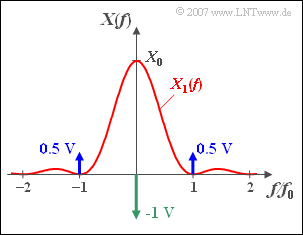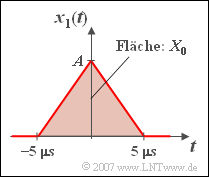Exercise 3.2Z: Sinc-Squared Spectrum with Diracs
The sketched spectrum ${X(f)}$ of a time signal ${x(t)}$ is composed of
- a continuous component $X_1(f)$,
- plus three dirac-shaped spectral lines.
The continuous component with $f_0 = 200\, \text{kHz}$ and $X_0 = 10^{–5} \text{ V/Hz}$is as follows:
- $$X_1( f ) = X_0 \cdot {\mathop{\rm si}\nolimits} ^2 ( {\pi {f}/{f_0}} ),\quad {\rm where is}\quad {\mathop{\rm si}\nolimits} (x) = {\sin (x)}/{x}.$$
The spectral line at $f = 0$ has the weight $–\hspace{-0.08cm}1\,\text{V}$. In addition, there are two lines at frequencies $\pm f_0$, both with weight $0.5\,\text{V}$.
Hints:
- This exercise belongs to the chapter Fourier Transform and Its Inverse.
- Further information on this topic can be found in the learning video Kontinuierliche und diskrete Spektren.
- It can be assumed as known that a triangular pulse $y(t)$ symmetrical about $t = 0$ with the amplitude ${A}$ and the absolute duration $2T$ $($i.e.: he signal values are unequal to$0)$ only between $–T$ and $+T$ has the following spectral function:
- $$Y( f ) = A \cdot T \cdot {\rm si}^2 ( \pi f T ).$$
Question
Musterlösung
(1) Die einseitige Dauer des symmetrischen Dreieckimpulses beträgt $T = 1/f_0\hspace{0.15 cm}\underline{ = 5 \,{\rm µ s}}$.
- Der Spektralwert $X_0 = X_1(f = 0)$ gibt die Impulsfläche von $x_1(t)$ an.
- Diese ist gleich ${A} \cdot {T}$. Daraus folgt:
- $$A = \frac{X_0 }{T} = \frac{ 10^{-5}\rm V/Hz }{5 \cdot 10^{-6}{\rm s}}\hspace{0.15 cm}\underline{= 2\;{\rm V}}.$$
(2) Der Gleichsignalanteil ist durch das Diracgewicht bei $f = 0$ gegeben. Man erhält ${B} \hspace{0.15 cm}\underline{= -1 \,\text{V}}$.
(3) Die beiden Spektrallinien bei $\pm f_0$ ergeben zusammen ein Cosinussignal mit der Amplitude ${C} \hspace{0.15 cm}\underline{= 1 \text{V}}$.
(4) Der Maximalwert tritt zum Zeitpunkt ${t} = 0$ auf (hier sind Dreieckimpuls und Cosinussignal maximal):
- $$x_{\text{max}} = A + B + C \hspace{0.15 cm}\underline{= +2 \text{V}}.$$
- Die minimalen Werte von ${x(t)}$ ergeben sich dann, wenn der Dreieckimpuls abgeklungen ist und die Cosinusfunktion den Wert $–\hspace{-0.08 cm}1 \,\text{V}$ liefert:
- $$x_\text{min} = {B} - {C}\hspace{0.15 cm}\underline{ = -2\, \text{V}}.$$

